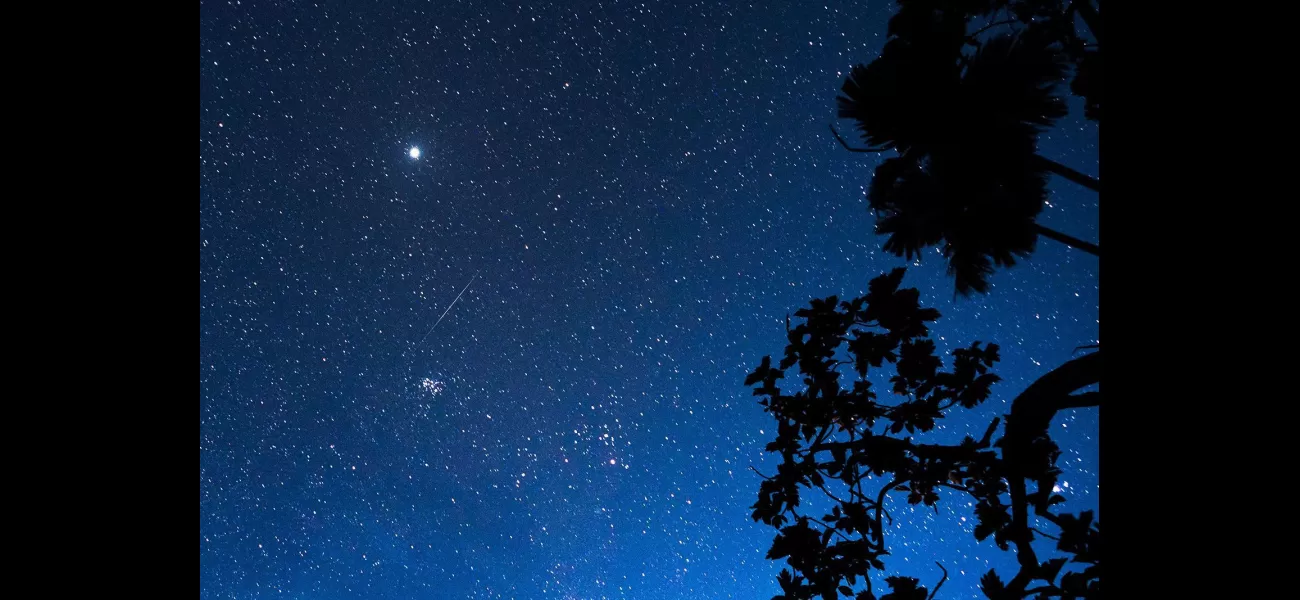Meteor shower expected to light up the sky in highly anticipated display.
"Expect 100 meteors per hour traveling at 214,365 km/h."
August 12th 2024.

As the summer season reaches its peak, it's time for one of the most highly anticipated celestial events of the year: the Perseid meteor shower. This dazzling display of light and color is known for its spectacular streams of fireballs that shoot across the sky, leaving behind a trail of bright streaks that linger even after the meteors have passed through the atmosphere.
While the Perseids can be seen annually from mid-July to September 1, this year's shower is set to peak between Sunday and early Monday morning. Experts are predicting up to 100 meteors per hour, traveling at an astonishing speed of 214,365 kilometers per hour. It's truly a sight to behold.
Bill Cooke, head of NASA's Meteoroid Environment Office, describes the Perseids as the most abundant meteor shower of the year, thanks to its stunning fireballs. He even goes as far as to compare it to a celestial fireworks display. These fireballs, which can be as bright as Venus, can reach sizes of over 1 meter in diameter.
According to Robert Lunsford, the fireball report coordinator for the American Meteor Society, these bright meteors are even brighter than any star or planet in the sky. They leave behind a distinct streak that resembles smoke, slowly dissipating over a few seconds. It's a truly mesmerizing sight, much like human-made fireworks.
This year, the Perseids are expected to be even more spectacular because the moon's light will not overshadow the fainter meteors, allowing viewers to see both the brighter ones and the dimmer ones. Cooke urges everyone to take advantage of this opportunity to witness the celestial fireworks show and not miss out like last year, when the moon's brightness hindered the view.
During the peak of the shower, the moon will only be 50% illuminated and will set around midnight, creating the perfect conditions for meteor watching. With the dark skies contrasting against the bright fireballs, it's an experience that shouldn't be missed.
As Cooke says, meteor showers happen all the time, but most of them are too weak to be noticed. The Perseids, on the other hand, are a rare opportunity to witness the beauty of these celestial events and learn more about the comets that produce them. It's both educational and fun, much like having another Fourth of July celebration.
The Perseids were first discovered in 1865 by Italian astronomer Giovanni Schiaparelli, who found that they were caused by Earth passing through debris trails released by the comet Swift-Tuttle. Hence, the name Perseids, which comes from the location in the sky where they appear to originate from - the constellation Perseus.
To view the Perseids, NASA's Cooke suggests finding a dark area without light pollution and lying down on your back to take in as much sky as possible. Give your eyes about 30 to 45 minutes to adjust to the darkness, and avoid looking at your cell phone, which can ruin your night vision. Lunsford also recommends bringing a comfortable chair to fully enjoy the experience and avoid any sources of light that may hinder your view.
The best time to view the shower is after midnight, around 2 am, when the source of the meteors will be highest in the northeastern sky. Cooke jokes that Mother Nature doesn't care about people's sleep schedules, so it's worth staying up a little later to witness this breathtaking event.
While the Perseids can be seen in the Northern Hemisphere, the best spot to view them is in the middle of the Pacific Ocean or in Hawaii, according to Lunsford. Unfortunately, they are not visible in Antarctica due to the radiant never rising in the view of the sky there.
To add to the excitement, the Perseids hold a special place in popular culture, with references to them in songs like John Denver's "Rocky Mountain High." Cooke shares that Denver was talking about the Perseids in this famous song, as he witnessed them from Colorado. It's just another reason to go outside and witness this magnificent show.
And if you can't catch the Perseids, there are still plenty of other meteor showers to look forward to throughout the year. From the Draconids in October to the Ursids in December, there's always something happening in the night sky. So grab a chair, find a dark spot, and enjoy the wonders of the universe.
While the Perseids can be seen annually from mid-July to September 1, this year's shower is set to peak between Sunday and early Monday morning. Experts are predicting up to 100 meteors per hour, traveling at an astonishing speed of 214,365 kilometers per hour. It's truly a sight to behold.
Bill Cooke, head of NASA's Meteoroid Environment Office, describes the Perseids as the most abundant meteor shower of the year, thanks to its stunning fireballs. He even goes as far as to compare it to a celestial fireworks display. These fireballs, which can be as bright as Venus, can reach sizes of over 1 meter in diameter.
According to Robert Lunsford, the fireball report coordinator for the American Meteor Society, these bright meteors are even brighter than any star or planet in the sky. They leave behind a distinct streak that resembles smoke, slowly dissipating over a few seconds. It's a truly mesmerizing sight, much like human-made fireworks.
This year, the Perseids are expected to be even more spectacular because the moon's light will not overshadow the fainter meteors, allowing viewers to see both the brighter ones and the dimmer ones. Cooke urges everyone to take advantage of this opportunity to witness the celestial fireworks show and not miss out like last year, when the moon's brightness hindered the view.
During the peak of the shower, the moon will only be 50% illuminated and will set around midnight, creating the perfect conditions for meteor watching. With the dark skies contrasting against the bright fireballs, it's an experience that shouldn't be missed.
As Cooke says, meteor showers happen all the time, but most of them are too weak to be noticed. The Perseids, on the other hand, are a rare opportunity to witness the beauty of these celestial events and learn more about the comets that produce them. It's both educational and fun, much like having another Fourth of July celebration.
The Perseids were first discovered in 1865 by Italian astronomer Giovanni Schiaparelli, who found that they were caused by Earth passing through debris trails released by the comet Swift-Tuttle. Hence, the name Perseids, which comes from the location in the sky where they appear to originate from - the constellation Perseus.
To view the Perseids, NASA's Cooke suggests finding a dark area without light pollution and lying down on your back to take in as much sky as possible. Give your eyes about 30 to 45 minutes to adjust to the darkness, and avoid looking at your cell phone, which can ruin your night vision. Lunsford also recommends bringing a comfortable chair to fully enjoy the experience and avoid any sources of light that may hinder your view.
The best time to view the shower is after midnight, around 2 am, when the source of the meteors will be highest in the northeastern sky. Cooke jokes that Mother Nature doesn't care about people's sleep schedules, so it's worth staying up a little later to witness this breathtaking event.
While the Perseids can be seen in the Northern Hemisphere, the best spot to view them is in the middle of the Pacific Ocean or in Hawaii, according to Lunsford. Unfortunately, they are not visible in Antarctica due to the radiant never rising in the view of the sky there.
To add to the excitement, the Perseids hold a special place in popular culture, with references to them in songs like John Denver's "Rocky Mountain High." Cooke shares that Denver was talking about the Perseids in this famous song, as he witnessed them from Colorado. It's just another reason to go outside and witness this magnificent show.
And if you can't catch the Perseids, there are still plenty of other meteor showers to look forward to throughout the year. From the Draconids in October to the Ursids in December, there's always something happening in the night sky. So grab a chair, find a dark spot, and enjoy the wonders of the universe.
[This article has been trending online recently and has been generated with AI. Your feed is customized.]
[Generative AI is experimental.]
0
0
Submit Comment





